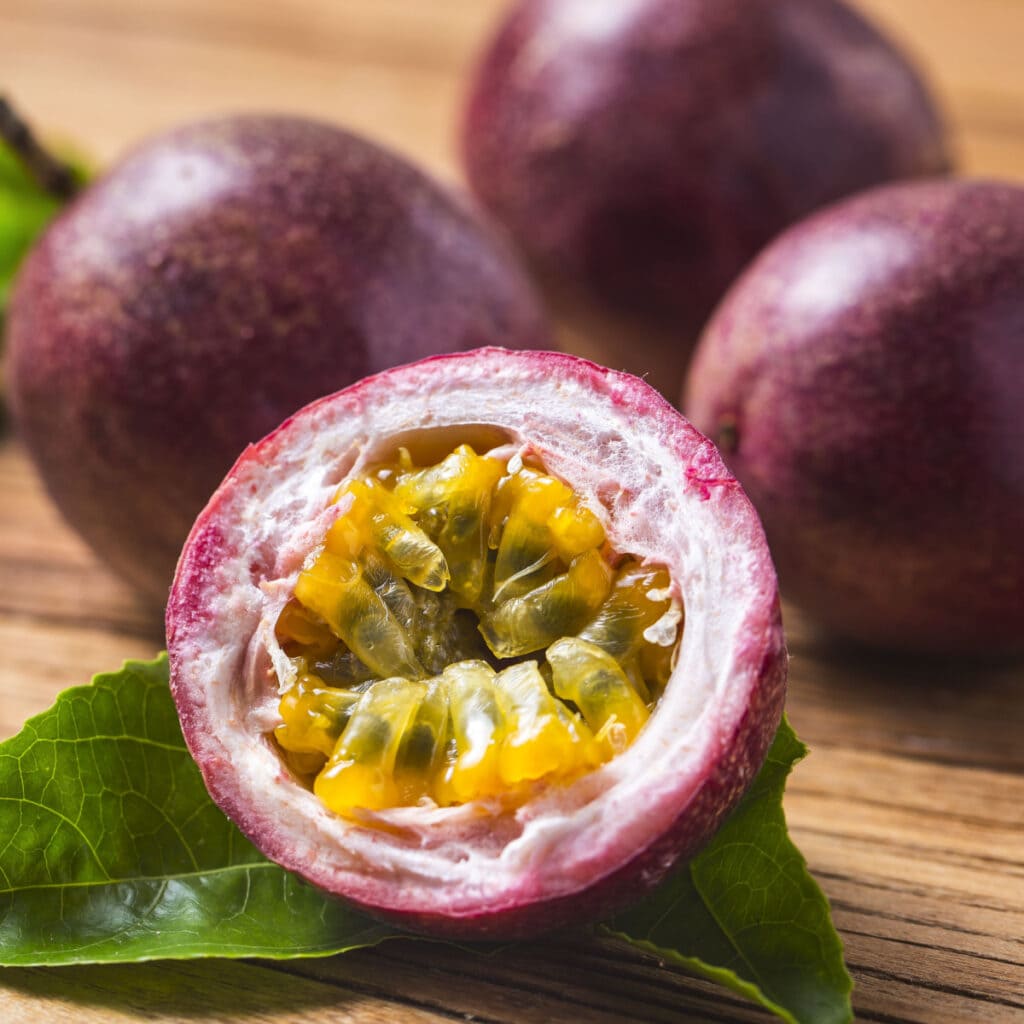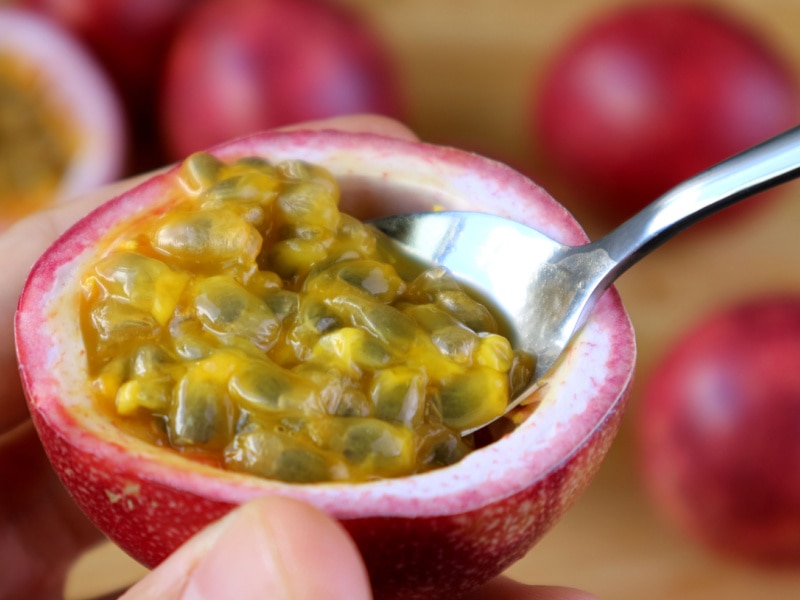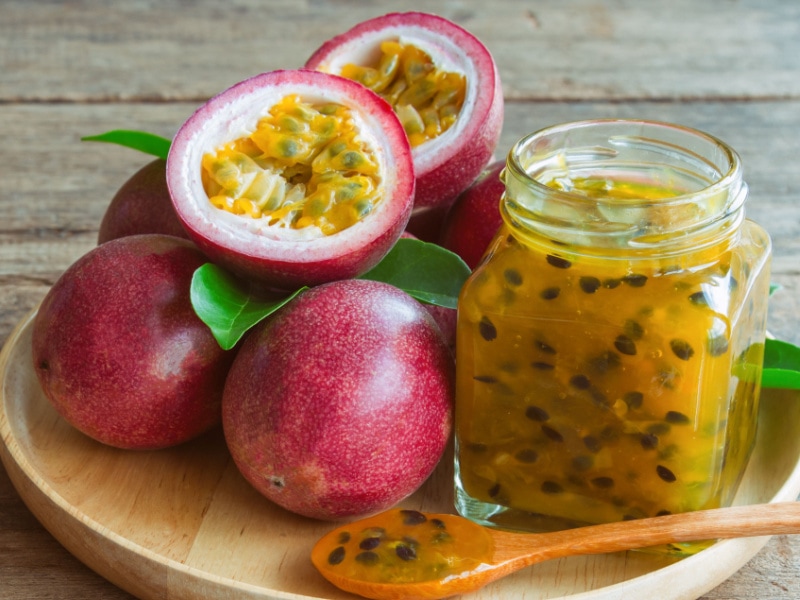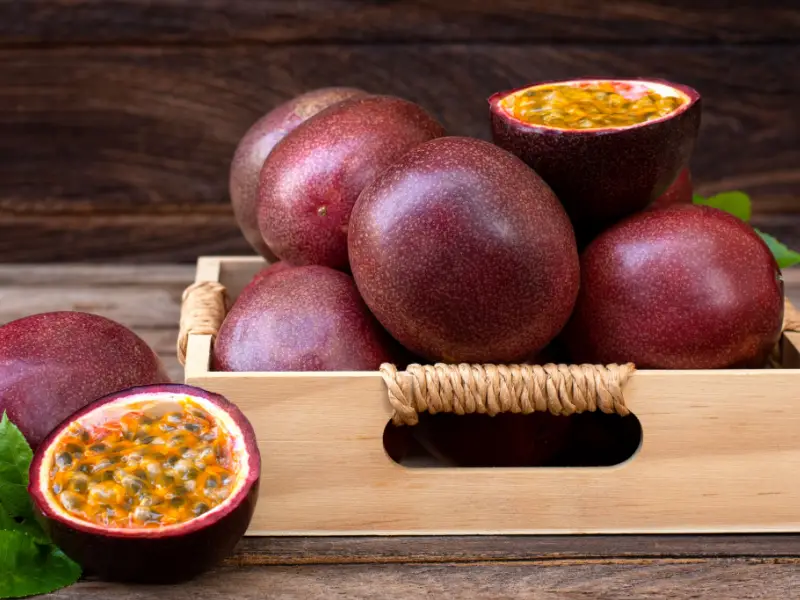



I know I'm not the only one wondering passion fruit: how to eat it and what it tastes like.
So let's explore this tropical delicacy together!
Do you want to save this weblog post? Enter your email now and we'll send the article straight to your inbox!

At first glance, passion fruit can seem a bit scary.
If you've never had one, you're probably confused about how to eat it - it's a bit sloppy!
You may also not know how to choose the best one or how to prepare it.
Luckily, I've got you covered. This post is going to go over everything related to passion fruit, including how to eat it and what it tastes like.
Spoiler: it's exquisite!
What is passion fruit?
Passion fruit is a genus of passion flower from the Passiflora vine. Native to southern Brazil and northern Argentina, the passion fruit is usually small and round (sometimes oval) with a juicy center full of pulp and seeds. Certain species are also cultivated in Australia.
This exquisite tropical fruit has tons of flavor and health benefits. You just have to get through the outer layer first, which is quite hard and inedible.
Inside you will find a super juicy pulp of bright colors with many seeds.
Passion fruit has a surprising amount of fiber, as well as many vitamins and antioxidants. And it comes in a range of colors and sizes.
The most common are purple and yellow.
Passiflora edulis has purple skin and is small and round. The yellow ones are called Passiflora flavicarpa, they are a little larger and also round or oval.
Passion fruits are a tropical fruit; However, they can also survive in subtropical times. This makes them easy to find all over the world!
Do you want to save this weblog post? Enter your email now and we'll send the article straight to your inbox!
What does passion fruit taste like?
If you love tropical fruits, you will love the passion fruit flavor.
Passion fruit tastes like a unique blend of tart and sweet with a very floral finish and citrus notes. It's a bit like pineapple or yellow kiwi, although some claim it has notes of grapefruit, pear and guava. Passion fruit is completely unique and tastes different depending on its color and ripeness.
When used in baked goods and desserts, passion fruit is often combined with buttery ingredients to help soften it.
Passion fruit juice can be used to flavor all types of recipes. It is a strong and refreshing tropical flavor that is very simple to like.

How to eat passion fruit
Passion fruit can be enjoyed in many different ways. But the easiest way to eat it is to cut it in half and remove the pulp.
If you have chosen a particularly acidic fruit, sprinkle a little sugar to give it more sweetness.
Similar to an orange or lemon, the inside of the skin has a white pith. Avoid eating this part as it has a somewhat bitter taste.
You can also make passion fruit juice by straining it through a fine mesh sieve. It won't generate much juice, but you won't have the crackling seeds to work with.
If you want a puree for baking, you can always mix the seeds and pulp. Then strain to get a smoother texture.
How to know when passion fruit is ripe
As passion fruit ripens, the skin will darken.
Yellow passion fruits will change to a dark yellow, red or orange color. Meanwhile, the purple varieties become very dark, sometimes practically black.
You can also gauge the ripeness of a passion fruit by the texture of the skin. If it has a somewhat wrinkled texture, it's probably time to break it open!
If it is extremely wrinkled, you have missed the window.
If the skin is still soft, wait a little longer. Passion fruit is still going to be too sour to eat.
Tips for selecting passion fruit
Although the softer passion fruits are sour, they are still edible. Simply add sugar or use them in recipes and sweetened juices.
You may find a passion fruit that is a little green. These fruits are not yet ripe and may not be good to eat. They may still be empty and dry on the inside.
If you find passion fruits that are hard or excessively wrinkled, they are probably past their peak and may become moldy at this stage.
If you have passion fruits at home, try to eat them within a week or store them in the refrigerator to extend their shelf life.

Can you eat passion fruit seeds?
Passion fruit seeds are completely edible. In truth, they contribute a lot to the tart flavor of this tropical fruit. Because they are so small, they can be swallowed whole. They can also be chewed and have a slightly crackling texture. Finally, they can be pureed to give a smooth finish.
Passion fruit seeds have a lot of fiber and are great for digestion. So eat!
How to store passion fruit
Passion fruit makes a great snack or dessert, so it's great to have at home.
If they are even minimally ripe, store them at room temperature for up to a couple of weeks. But if you open one, it should go in the refrigerator.
Place the opened passion fruits in an airtight container and store them in the cool compartment of your refrigerator for 7 to ten days.
If you store whole passion fruits in the refrigerator, place them in an airtight container, and they will last for about a month!
My favorite way to store passion fruit is in ice cube trays in the freezer. Simply scoop out the pulp, place it on a tray, and freeze.
This makes it simple to add to recipes like smoothies and sauces.
Passion fruit should last about a month in the freezer.

When is passion fruit in season?
Passion fruit is more abundant in the warmer months. The beginning of summer through winter is the peak of the development season. However, tropical passion fruits are available all year round. As they are grown all over the world, they do not have a specific season.
Of course, with its radiant color and sweet and sour flavor, it is ideal for summer recipes and drinks!

